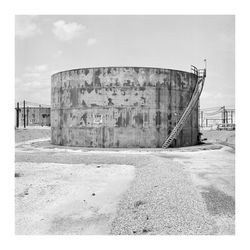Steve Kahn
Fine Art Photography
Chemical Pants 1989
Click on image below for slideshow and captions.
 |  |
|---|---|
 |  |
 |  |
 |  |
 |  |
 |  |
 |  |
 |  |
 |  |
 |  |
During the 1980's, I had the opportunity of photographing a number of refineries and chemical production facilities in the US. In particular, I visited two huge complexes that were part of Union Carbide's operations in the South. I was fascinated by these futuristic cities of pipes, towers, and foul smells – non-architectural industrial constructions of form following (obscure) function.
Chemical plants are dangerous environments; one does not wander unaccompanied or without having undergone safety training and suiting-up in bulky, protective gear. The accidental release of toxic substances, gas or liquid, is a real and constant threat. As a result, these vast acres of contained chemical reactions, like coal mines, oil rigs and nuclear facilities, are off-limits to the public. Nothing of nature grows there, and very few people have any reason, let alone permission, to visit.
In July of 1989 I spent a week photographing at the Seadrift plant near Victoria, Texas, and at the Taft plant just north of New Orleans. Typically for that time of year in the South, it was hot and humid – conditions that were compounded by heat generated within each complex itself. I produced a 60-print portfolio of the work, providing a rare look beyond the security gates into this mysterious, hostile world.
The 1989 Exxon Valdez spill followed on the heels of the Bhopal disaster in 1984, after which access to any facility even remotely connected to the oil or chemical industry closed to the press everywhere.
Although these images were originally photographed on b/w film, gelatin silver prints were never made. This 2012 edition of archival pigment prints is the first time these images have been printed.